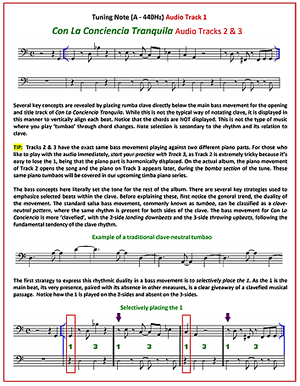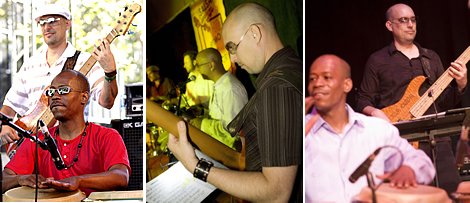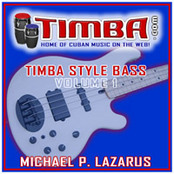Learn to play TIMBA Style Bass with this highly focused and in-depth analysis of one of the genre's iconic masterpiece albums -Con La Conciencia Tranquila by Paulito F.G. This album + book combination features full transcriptions of the trend setting bassist Joel Domínguez along with piano accompanyment from pianists Rolando Luna and Yosvel Bernal. Clave based bass movement and strategies explained. HIGHLY RECOMMENDED for all musicians studying contemporary afro-cuban styles!
** The TIMBA Style Bass ALBUM (audio) and eBOOK (book + sheet music) are sold separately.
** La descarga del album (audio) y el libro (partituras) se venden separadamente.
 This English language instructional play-along album + digital eBook combination is your ticket to the grooviest bass movements on the planet! If you've every wondered how to play those funky, clave based bass parts featured in comntemporary Cuban dance music (TIMBA) then this is the book for you. With this highly focused and in-depth analysis of one of the genre's iconic masterpiece albums -Con La Conciencia Tranquila by Paulito F.G, this album + book combination provides you with in-delth explanations and analysis of the bass movement along with its relation to the clave. The eBook features full transcriptions of the trend setting bassist Joel Domínguez along with piano accompanyment from pianists Rolando Luna and Yosvel Bernal.
This English language instructional play-along album + digital eBook combination is your ticket to the grooviest bass movements on the planet! If you've every wondered how to play those funky, clave based bass parts featured in comntemporary Cuban dance music (TIMBA) then this is the book for you. With this highly focused and in-depth analysis of one of the genre's iconic masterpiece albums -Con La Conciencia Tranquila by Paulito F.G, this album + book combination provides you with in-delth explanations and analysis of the bass movement along with its relation to the clave. The eBook features full transcriptions of the trend setting bassist Joel Domínguez along with piano accompanyment from pianists Rolando Luna and Yosvel Bernal.
Audio album features 23 tracks. All 14 instructional tracks have stereo separation for the piano and bass --meaning you can use the 'Balance' control on your system to pan from the right channel (bass + percussion) to the left channel (piano + percussion). The remaining 9 are from the Con La Conciencia Tranquila itself so that you can hear the bass parts in context with the vocals.
TIMBA Style Bass Volume 1 (Audio Album): Complete Track List
| Track # |
Title |
Play time |
| 1 |
Bass Tuning Note |
0:26 |
| 2 |
Bass Con La Conciencia |
0:47 |
| 3 |
Bass Con La Conciencia 2 |
0:48 |
| 4 |
Bass Y Ahora Que |
0:49 |
| 5 |
Bass Y Ahora Que 2 |
2:01 |
| 6 |
Bass Entre dos Amigos |
0:47 |
| 7 |
Bass Mi Tentacion |
0:51 |
| 8 |
Bass Llamada Anonima |
0:43 |
| 9 |
Bass Para Volver |
0:55 |
| 10 |
Bass Para Volver 2 |
0:53 |
| 11 |
Bass Y San Toma Que |
0:45 |
| 12 |
Bass No Te Lo Creas |
0:47 |
| 13 |
Bass De La Habana |
1:06 |
| 14 |
Bass De La Habana 2 |
0:43 |
| 15 |
Con La Conciencia Tranquila |
4:36 |
| 16 |
De La Habana |
5:24 |
| 17 |
Entre Dos Amigos |
4:37 |
| 18 |
Llamada Anónima |
5:21 |
| 19 |
Mi Tentación |
4:15 |
| 20 |
No Te Lo Creas |
5:36 |
| 21 |
Para Volver Conmigo |
5:49 |
| 22 |
Y Ahora Que |
5:32 |
| 23 |
Y San Toma Que |
5:46 |
Aprenda a tocar bajo en el estilo de la música conocido por TIMBA -género contemporaneo de la música bailable de Cuba- con este enfocado análisis profundo de una de las mayores obras de la música cubana: Con La Conciencia Tranquila de Paulito FG. Esta combinación de pistas + libro digital incluye transcripciones del infalible bajista Joel Domínguez junto a los montunos de Rolando Luna y Yosvel Bernal. Inclute explicación de las mayores estrategias para crear movimientos en el bajo basados en la clave. Aunque el libro es en inglés es MUY RECOMENDADO para todo estudiante serio de la música afro-cubana!
About the Author: Born and raised in Mayagüez, Puerto Rico, Michael Lazarus is a North California Bay Area based music professional with recording, touring and teaching experience who specializes in Caribbean music. Now focused on original music projects and production, he is working in collaboration with international timba music artists. Mike is currently the Advanced Bass Instructor at Sylvan Music in Santa Cruz, California. Email him at: michael [at] puracepa.com.

What is TIMBA ?
Timba is contemporary Cuban dance music. One easy way to tell the difference between a salsa band and a timba one is the presence of a full drum-set. Its funk based beats go along with very syncopated and distinct piano and bass movements. Timba has its roots deep in the Cuban rumba -a folkloric genre native to the island. Underneath the horns and the rapping you can still hear the African rhythms, largely unchanged for generations. In Timba, rumba's sophisticated density is carried on and applied to a big band format.
Origins of TIMBA
In the 1940's and 50's, Cuban musicians traveled to New York and took the mambo with them. They were joined by NY native Hispanic musicians, mostly Puerto Rican, and the mambo took on a distinctly New York sound. It then spread across the US as the famous 'Mambo Craze'.
Then in the turbulent 1960's, young New York musicians took up the mambo and transformed it, adding socially conscious lyrics and musical elements from their native Puerto Rico and the Dominican Republic, namely their indigenous rhythms of bomba, plena, and merengue, as well as jazz, rock and disco. They simply called this hot mélange of sounds Salsa.
Through the 1970's salsa continued to evolve and expand. Salsa spread around the world, through Latin America and the Caribbean, particularly Colombia, which has become a hotbed of salsa creativity, and as far away as Japan (which developed several world class salsa bands of purely Japanese musicians).
In the early 1980s Cuban artists like Elio Revé and Adalberto Álvarez began to incorporate distinctly salsa sounds into their music. Then NG La Banda burst onto the scene, took New York style salsa, added sounds from the innovative Cuban Latin jazz group Irakere, had the chorus (coro) start with chanting like the rappers that were starting to take off in the U.S., turning the voice into a rhythm instrument, added classical influences that all Cuban musicians learn in music school, and Timba was born.
For all things TIMBA please visit www.TIMBA.com.








 This English language instructional play-along album + digital eBook combination is your ticket to the grooviest bass movements on the planet! If you've every wondered how to play those funky, clave based bass parts featured in comntemporary Cuban dance music (TIMBA) then this is the book for you. With this highly focused and in-depth analysis of one of the genre's iconic masterpiece albums -Con La Conciencia Tranquila by Paulito F.G, this album + book combination provides you with in-delth explanations and analysis of the bass movement along with its relation to the clave. The eBook features full transcriptions of the trend setting bassist Joel Domínguez along with piano accompanyment from pianists Rolando Luna and Yosvel Bernal.
This English language instructional play-along album + digital eBook combination is your ticket to the grooviest bass movements on the planet! If you've every wondered how to play those funky, clave based bass parts featured in comntemporary Cuban dance music (TIMBA) then this is the book for you. With this highly focused and in-depth analysis of one of the genre's iconic masterpiece albums -Con La Conciencia Tranquila by Paulito F.G, this album + book combination provides you with in-delth explanations and analysis of the bass movement along with its relation to the clave. The eBook features full transcriptions of the trend setting bassist Joel Domínguez along with piano accompanyment from pianists Rolando Luna and Yosvel Bernal.
